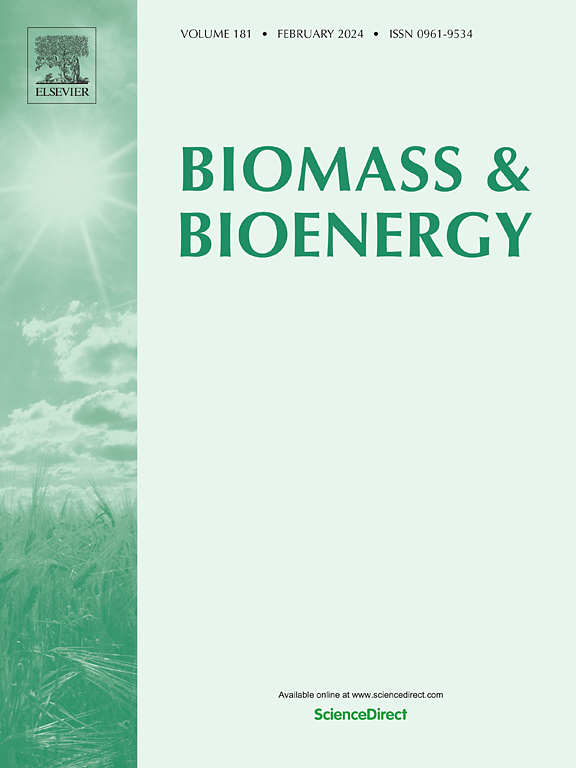利用热重/傅立叶变换红外分析和洗牌复合进化算法分析去皮棉秆的热降解过程
IF 5.8
2区 生物学
Q1 AGRICULTURAL ENGINEERING
引用次数: 0
摘要
棉花是全球最重要的农作物之一,被广泛种植。本研究采用热重/傅立叶变换红外分析法(TG-FTIR),在加热速率为 5 至 60 K/min 的条件下,系统地研究了去皮棉秆的热解特性和产物分布。使用两种无模型方法估算了动力学参数,结果表明热解活化能在 182.97 至 213.11 kJ/mol 之间变化。三组分平行反应模型结合洗牌复杂进化算法对实验数据进行了逆建模。得到了独立的半纤维素、纤维素和木质素的相应精确动力学参数。结果表明,基于优化动力学参数的预测值与实验数据十分吻合。最后,在额外加热速率下对实验曲线的盲预测进一步证实了优化动力学参数的精确性和适用性。傅立叶变换红外分析表明,在不同的加热速率下,与峰值相关的吸收光谱基本保持一致。气体成分的演变模式与导数热重曲线中观察到的趋势一致,产生的气体按以下顺序排列:二氧化碳、甲醛、甲醇、一氧化碳,最后是甲烷。本文章由计算机程序翻译,如有差异,请以英文原文为准。

Thermal degradation of peeled cotton stalk with thermogravimetry/fourier transform infrared analysis and shuffled complex evolution algorithm
Cotton is one of the most important crops globally and is widely planted. This study systematically investigated the pyrolysis characteristics and product distribution of peeled cotton stalks using thermogravimetry/Fourier transform infrared analysis (TG-FTIR) at heating rates ranging from 5 to 60 K/min. Kinetic parameters were estimated using the two model-free methods, and the results revealed that the activation energy for pyrolysis varied between 182.97 and 213.11 kJ/mol. The three-component parallel reaction model, combined with the Shuffled Complex Evolution algorithm, was applied to perform inverse modeling of the experimental data. The corresponding exact kinetic parameters for independent hemicellulose, cellulose and lignin were obtained. The results revealed that the predicted values based on the optimized kinetic parameters were in good agreement with the experimental data. Ultimately, the blind prediction of the experimental curves at extra heating rates further confirmed the precision and suitability of the optimized kinetic parameters. The FTIR analysis indicated that the absorption spectra related to the peaks remained largely consistent at various heating rates. The evolution patterns of the gas components aligned with the trends observed in the derivative thermogravimetric curves, with the produced gases in the following order: CO2, formaldehyde, methanol, CO, and finally methane.
求助全文
通过发布文献求助,成功后即可免费获取论文全文。
去求助
来源期刊

Biomass & Bioenergy
工程技术-能源与燃料
CiteScore
11.50
自引率
3.30%
发文量
258
审稿时长
60 days
期刊介绍:
Biomass & Bioenergy is an international journal publishing original research papers and short communications, review articles and case studies on biological resources, chemical and biological processes, and biomass products for new renewable sources of energy and materials.
The scope of the journal extends to the environmental, management and economic aspects of biomass and bioenergy.
Key areas covered by the journal:
• Biomass: sources, energy crop production processes, genetic improvements, composition. Please note that research on these biomass subjects must be linked directly to bioenergy generation.
• Biological Residues: residues/rests from agricultural production, forestry and plantations (palm, sugar etc), processing industries, and municipal sources (MSW). Papers on the use of biomass residues through innovative processes/technological novelty and/or consideration of feedstock/system sustainability (or unsustainability) are welcomed. However waste treatment processes and pollution control or mitigation which are only tangentially related to bioenergy are not in the scope of the journal, as they are more suited to publications in the environmental arena. Papers that describe conventional waste streams (ie well described in existing literature) that do not empirically address ''new'' added value from the process are not suitable for submission to the journal.
• Bioenergy Processes: fermentations, thermochemical conversions, liquid and gaseous fuels, and petrochemical substitutes
• Bioenergy Utilization: direct combustion, gasification, electricity production, chemical processes, and by-product remediation
• Biomass and the Environment: carbon cycle, the net energy efficiency of bioenergy systems, assessment of sustainability, and biodiversity issues.
 求助内容:
求助内容: 应助结果提醒方式:
应助结果提醒方式:


